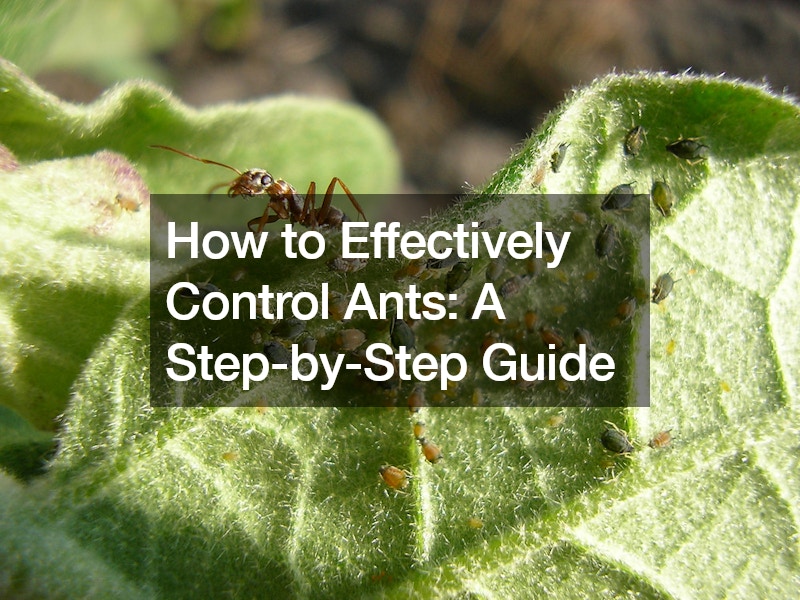
Ants are a common nuisance in many households, often invading kitchens, pantries, and other areas in search of food. While getting rid of them entirely can be challenging, there are effective methods you can employ to control their population and minimize their presence in your home. In this comprehensive guide, we’ll outline step-by-step strategies to help you effectively control ants and keep them at bay.
1. Identify Ant Behavior and Preferences
Understanding the behavior and preferences of ants is crucial for effective control. Ants are attracted to food sources, particularly sugars and proteins.
By observing their foraging patterns, you can determine what food they seek. Place bait traps with different types of food, such as sugar-based solutions or protein-rich baits, to identify their preferences.
2. Use Baiting Techniques
Baiting is one of the most effective methods for controlling ant populations. Choose ant baits specifically designed to attract and eliminate ants. These baits contain slow-acting toxins that ants carry back to their colonies, ultimately leading to the demise of the entire colony. Place bait stations along ant trails and near entry points to your home, ensuring that they are inaccessible to children and pets.
3. Apply Pesticides and Dusts
In addition to baiting, applying pesticides and dust can help eliminate ants that come into direct contact with these products. Select insecticides labeled for ant control and apply them to areas where ants are active, such as along baseboards, countertops, and entry points. Dust formulations can be particularly effective in cracks, crevices, and voids where ants may be nesting.
4. Avoid Repellent Products
When selecting ant control products, avoid those labeled as repellents. Repellent products may deter ants temporarily, but they can also cause ants to scatter and create new colonies, exacerbating the problem. Instead, opt for non-repellent insecticides that ants will readily come into contact with and carry back to their colonies.
5. Monitor and Maintain Treatment
Ant control is an ongoing process that requires monitoring and maintenance. Regularly inspect bait stations and pesticide applications to ensure they remain effective. Replace bait stations as needed and reapply insecticides according to the manufacturer’s instructions. By consistently monitoring and maintaining your treatment efforts, you can prevent ant populations from rebounding.
6. Target Common Entry Points
Ants typically enter homes through small cracks, gaps, and openings in walls, windows, and doors. Seal off these entry points to prevent ants from gaining access to your home. Use caulk or weatherstripping to seal gaps around windows and doors and repair any cracks or holes in walls and foundations. By eliminating entry points, you can significantly reduce the likelihood of ant infestations.
7. Practice Good Sanitation
Maintaining a clean and sanitary environment is essential for ant control. Store food in airtight containers and promptly clean up crumbs, spills, and food debris. Wipe down countertops, sweep floors, and empty garbage regularly to remove potential food sources for ants. By denying ants access to food and water, you can make your home less appealing to them.
How to Effectively Control Ants Using Cutting-Edge Technology:
Ant infestations can be a persistent problem for homeowners, but with advances in technology, more effective methods are now available for ant control than ever before. In this comprehensive guide, we’ll explore how the latest advancements in pest control technology can help you effectively manage ant populations and maintain a pest-free home environment.
1. Advanced Baiting Systems
One of the most significant advancements in ant control technology is the development of advanced baiting systems. These systems utilize sophisticated formulations targeting ants while minimizing the impact on non-target organisms. Some baits are designed to disrupt the ants’ reproductive cycle, leading to long-term population suppression. Others contain slow-acting toxins transferred throughout the colony, resulting in widespread elimination.
2. Precision Application Methods
Modern pest control companies employ precision application methods to deliver insecticides and bait accurately. This ensures treatment targets ant-infested areas while minimizing exposure to humans, pets, and the environment. Advanced equipment, such as precision sprayers and bait dispensers, allows technicians to apply products more efficiently and effectively than ever before.
3. Remote Monitoring and Control
Another recent innovation in ant control technology is the development of remote monitoring and control systems. These systems use sensors and data analytics to track ant activity in real time, allowing pest control professionals to respond quickly to infestations as they occur. Remote monitoring systems can detect changes in ant behavior patterns, such as increased foraging activity or colony expansion, enabling proactive treatment before infestations escalate.
4. Eco-Friendly Solutions
With growing concerns about environmental sustainability, there has been a push for developing eco-friendly ant control solutions. Many modern pest control companies offer environmentally responsible alternatives to traditional insecticides, such as botanical extracts and microbial insecticides. These products are derived from natural sources and have minimal impact on non-target organisms, making them ideal for use in sensitive environments.
5. Integrated Pest Management (IPM)
Integrated Pest Management (IPM) is a holistic approach to pest control that combines multiple strategies to achieve long-term suppression of ant populations. This approach incorporates biological, mechanical, and cultural control methods alongside chemical treatments to create a comprehensive ant management plan. By integrating various control measures, IPM reduces reliance on chemical pesticides and minimizes the risk of pesticide resistance.
.
